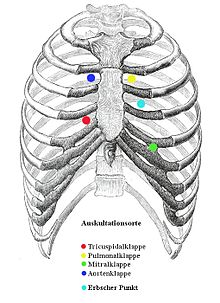Auscultation
Under auscultation (from Latin. Auscultare - (eagerly) listen, listen carefully, listen to) or eavesdropping is understood in the medical interception of the body, typically with the stethoscope (or stethoscope ). Auscultation is part of the physical exam . The corresponding verb is called auscultate , as a foreign word from Latin it is not separated (example: “she auscultated”, not “she cultivated”).
execution
Initially (with immediate auscultation) the ear was held directly on the surface of the body, as was already practiced by doctors in antiquity and is still done today if other means are not available. For example, the Succussio Hippocratis (an audible splashing noise with the ear placed on the chest wall or with a stethoscope when the patient shakes) can diagnose accumulations of fluid ( pleural effusions ) in the chest. The French doctor René Laënnec developed the modern (indirect) auscultation method of investigation mentioned as an idea also by the Italian anatomist and clinician Domenico Cotugno (1736–1822) in 1816 and made it public in 1819. Laënnec's first ear trumpet was a tightly rolled sheet of paper. The current technique of auscultation goes back to Josef von Škoda (1839).
During auscultation of the lungs , a distinction is made between normal vesicular ("vesicular") breathing noise and pathological forms such as bronchial and amphoric ("hollow sounding") breathing ( amphoric breathing noise ) and secondary breathing noises (rattling noises and rubbing noises).
During auscultation of the heart , a distinction is made between heart tones and heart murmurs , whereby the quality and volume of the noises can indicate damage to the valve apparatus or defects in the heart septum ( ASD , VSD ). In addition, the heart rhythm is assessed (e.g. gallop rhythms with a third and fourth heart sound). Rubbing noises indicate an inflammation of the pericardium ( pericarditis ), or leather creaking, already known as Hippocrates, indicates pleurisy sicca.
The heartbeat of the unborn child is listened to, especially in the late stages of pregnancy , in order to recognize at an early stage that the child is at risk in the event of complications.
During the auscultation of the abdomen , especially the bowel function is assessed in order to e.g. B. to be able to distinguish a paralytic from a mechanical ileus (intestinal obstruction). If the stethoscope is placed at an epigastric angle, renal artery stenosis can be auscultated.
Blood vessels are auscultated as well, for example the carotid artery in the neck, the axillary artery , the abdominal aorta , the femoral artery and the popliteal artery in the hollow of the knee. When there is a narrowing ( stenosis ) of the blood vessel, audible flow noises arise . This phenomenon is also used by the measurement of blood pressure according to Nikolai Sergejewitsch Korotkow .
A special form is the scratch auscultation .
Auscultation sites of the heart valves
- Pulmonary valve : 2nd intercostal space , to the left of the sternum (parasternal)
- Aortic valve : 2nd intercostal space, to the right of the sternum (parasternal)
- Tricuspid valve : 4th intercostal space, to the right of the breastbone (parasternal)
- Mitral valve : 5th intercostal space, left middle clavicle line (medioclavicular)
- Erb's point : 3rd intercostal space, to the left of the breastbone (parasternal)
literature
- Klaus Holldack, Klaus Gahl: Auscultation and percussion. Inspection and palpation. Thieme, Stuttgart 1955; 10th, revised edition ibid. 1986, ISBN 3-13-352410-0 , pp. 20-23, 77-99, 104-208, 213-217, 221-225, 229, 240 f., 243 f., 248 , 252, 256, 258 f. and more often.
- U. Koehler, V. Gross, C. Reincke, T. Penzel: Sound diagnostic procedures - the history of percussion and auscultation. In: Pneumology. Volume 58, 2004, pp. 525-530. doi : 10.1055 / s-2004-818416
Web links
- Auscultation of the lungs
- English, helpful auscultation animation of the heart ( memento from March 5, 2015 in the Internet Archive )
- English, auscultation of the lungs and heart
- Auscultation : Auscultation recordings
Individual evidence
- ↑ Volker Hess: Auscultation. In: Werner E. Gerabek , Bernhard D. Haage, Gundolf Keil , Wolfgang Wegner (eds.): Enzyklopädie Medizingeschichte . De Gruyter, Berlin 2005, ISBN 3-11-015714-4 , p. 123.
- ^ Rainer Brömer: Domenico Cotugno. In: Werner E. Gerabek u. a. (Ed.): Encyclopedia of medical history. 2005, p. 276.
- ^ Rene-Theophile-Hyacinthe Laennec: Traite de L'Auscultation Mediate Et Des Maladies Des Poumons Et Du Coeur . Paris 1819, 2 volumes; 4th edition by Andral, 1836, 3 volumes; German von Meißner, Leipzig 1822. Current fr. Edition (Ed.1828) (Sciences), Hachette Livre, 2012 ISBN 978-2-0126-2898-4 Online version
- ↑ www.wissen.de: amphoric breathing .
- ^ Klaus Holldack, Klaus Gahl: Auscultation and percussion. Inspection and palpation. Thieme, Stuttgart 1955; 10th, revised edition, ibid 1986, ISBN 3-13-352410-0 , p. 80 f.


